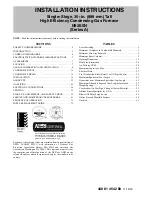
508189-01
Issue 2116
Page 16 of 42
Heating Components
Ignitor
The ignitor is made of durable silicon nitride. The integrated
control provides 120 volts to the ignitor for a consistent
ignition and long ignitor life. Ohm value should be 39 to 70.
See Figure 9 for ignitor location and Figure 10 for ignitor
check out.
NOTE:
The 80G2DFE furnace contains electronic
components that are polarity sensitive. Make sure that the
furnace is wired correctly and is properly grounded.
Flame Sensor
A flame sensor is located on the left side of the burner
support. See Figure 9. The sensor tip protrudes into the
flame envelope of the left-most burner. The sensor can
be removed for service without removing any part of the
burners. During operation, flame is sensed by current
passed through the flame and sensing electrode. The
control allows the gas valve to remain open as long as
flame signal is sensed. To check flame sense signal use
the push-button found on the integrated control and go to
Field Test Mode. The menu will display the flame signal.
To Measure Flame Signal - Integrated Control:
Use a digital readout meter capable of reading DC
microamps. See Figure 11 and Table 8 for flame signal
check.
1.
Set the meter to the DC amps scale.
2.
Turn off supply voltage to control.
3.
Disconnect integrated control flame sensor wire from
the flame sensor.
4.
Connect (-) lead to flame sensor.
5.
Connect (+) lead to the ignition control sensor wire.
6.
Turn supply voltage on and close thermostat contacts
to cycle system.
7.
When main burners are in operation for two minutes,
take reading.
Normal
Low
Drop Out
2.6 or greater
2.5 or less
0.06
Table 8. Flame Signal in Microamps
Gas Valve
The valve (Figure 13) is internally redundant to assure
safety shut-off. If the gas valve must be replaced, the same
type valve must be used.
24VAC terminals and gas control knob are located on the
valve. A wire harness connects the terminals from the gas
valve to the electronic ignition control. 24V applied to the
terminals energizes the valve.
Inlet and outlet pressure taps are located on the valve. A
regulator adjustment screw is located on the valve.
LPG change over kits are available from Allied. Kits include
burner orifices and a gas valve.
Flame Rollout Switches (S47)
Flame rollout switch is a high temperature limit located on
top of the burner box, one on each side.- See Figure 9.
The limit is a N.C. SPST manual-reset limit. When S47
senses rollout, the circuit breaks and the ignition control
immediately stops ignition and closes the gas valve.
Rollout can be caused by a blocked exchanger, flue or lack
of combustion air. The switch is factory set to trip (open) at
210°F and cannot be adjusted. The switch can be manually
reset. To manually reset a tripped switch, push the reset
button located on the control.
Burners
All units use inshot burners. Burners are factory set and
require no adjustment. Always operate the unit with the
burner box front panel in place. Each burner uses an orifice
that is precisely matched to the burner input. Burners can
be removed as a one piece assembly for service. If burner
assembly has been removed, it is critical to align center
of each burner to the center of the clamshell when re-
installing. See more detail in the Maintenance section.
Primary Limit Control (S10)
The primary limit (S10) is located in the heating vestibule
panel. When excess heat is sensed in the heat exchanger,
the limit will open. If the limit is open, the furnace control
energizes the supply air blower and closes the gas valve.
The limit automatically resets when unit temperature
returns to normal. The switch must reset within three
minutes or the control will go into Watch guard for one
hour. The switch is factory set and cannot be adjusted. The
switch may have a different set point for each unit model
number.






































